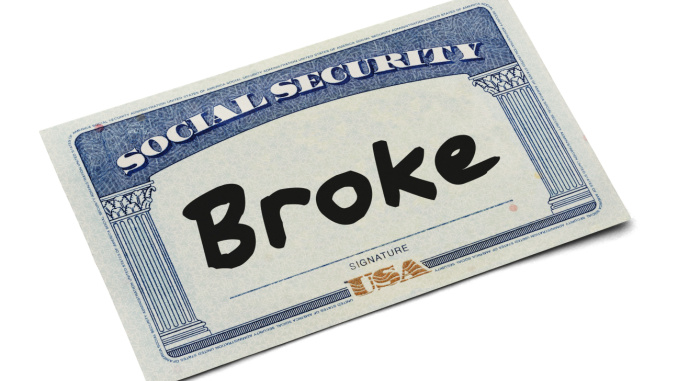
by Dr. Thomas Patterson | Apr 14, 2023 | Opinion
By Dr. Thomas Patterson |
Americans were outraged to learn of the Nashville school shooting, where a transgender female shot and killed three children and three adults at a Christian school.
As always, a fierce political debate broke out after the murders. Gun control advocates, mostly Democrats, again made impassioned and often vitriolic pleas for more stringent gun laws.
It would be a wonderful world if there were some laws we could pass, some clever strategy to keep criminals from having guns. The big problem is that gun control laws don’t work, much as we might wish otherwise. If they did, Chicago, Baltimore, and other big cities, with their strict gun laws on the books, wouldn’t be the murderous hell-holes that they are.
It’s been pointed out many times, but it’s still true: violent criminals don’t follow the law. The victims are the law-abiding citizens who bring knives to a gun fight.
Conservative commentator Matt Vespa recently wrote a thoughtful column advocating instead for posting “resource officers” in every school. He notes that it took 14 minutes for police to arrive at the Nashville shooting, and that other killers have had even more time before facing significant deterrence.
On the other hand, there are many accounts of officers in schools who were able to prevent potential murders just by being present.
But there’s a problem. There are approximately 115,000 K-12 schools in the U.S., according to Dun and Bradstreet. If we lowball an estimate of $50,000 yearly to support an FTE, that means placing an officer in every school would, according to my back-of-the-napkin calculator, cost at least $5 and $6 billion annually.
That would be a justifiable cost if we were facing an epidemic of school killings, but the numbers tell a different story. Although the especially traumatic nature of school killings and extensive media coverage make the shootings seem commonplace, for the last 35 years, school shooting deaths have hovered around 20–30 per year, less than one for every two states.
From 2010 to 2019, there were 305 incidents involving guns and 207 deaths—or about 20 per year. Arizona, with about 2,700 schools, has had one shooting death ever, in 1987, in addition to four suicides and one accidental death.
For American schools, this computes to an annual average of one shooting death for every 4,000 schools. Full-time school resource officers would, over the course of a career, have an infinitesimal chance of preventing even one shooting.
Throwing money at a problem without a sober cost-benefit analysis, however passionately we may feel about it, seldom works out. A more practical solution would be to authorize one or more teachers per school to carry concealed weapons.
These teachers would be volunteers who are licensed carriers and would undergo additional training in the very focused area (confronting an armed criminal in a school setting) that their duty might entail. They would receive a modest stipend.
Would recruiting be a problem? I like to think there are enough teacher-heroes with a heart for their students who would be willing and up to the task if called upon. Remember, it has often been teachers who answered the call when peace officers cowered in emergency situations, as in Uvalde and Parkland.
Moreover, the deterrent effect of armed teachers would be inarguable. Schools would be changed from soft targets with idiotic “Gun Free Zone” signs into places where criminals with bad intentions would know they were risking their lives by entering.
Unfortunately, the teachers’ unions have pitched a fit. Their purported worries include the safety of their members, the qualifications of the volunteers, and the image of teachers involved with violence.
Their arguments are easily rebuffed, remembering that no solution is perfect, and the point is to pick the best available. But the unions are powerful, tough competitors in public debate, even when the facts and arguments are against them, as when the schools were shut down during COVID on their demand.
Wasting a few more billion in a nation over $30 trillion in debt may not seem like much, but we have to start somewhere. Let’s believe in our educators and look to American resilience and resourcefulness to protect our children.
Dr. Thomas Patterson, former Chairman of the Goldwater Institute, is a retired emergency physician. He served as an Arizona State senator for 10 years in the 1990s, and as Majority Leader from 93-96. He is the author of Arizona’s original charter schools bill.

by Dr. Thomas Patterson | Mar 31, 2023 | Opinion
By Dr. Thomas Patterson |
Joseph Schumpeter was an Austrian born economist who last century coined the term “creative destruction” to describe the method by which capitalism continually reinvigorates itself. Unlike the static monarchical guild-based economies or the now-pervasive socialist states, capitalism is in constant turmoil. Ceaseless competition produces winners, losers – and progress.
Schumpeter’s key insight was that failure is essential to capitalism’s success. The outmoded and inefficient must give way to more successful models for capitalism to work its magic as the most beneficial-for-all economic engine of all time.
But that doesn’t mean the short-term consequences of failure aren’t painful to those who bear them. Buggy manufacturers, candlemakers, and others overtaken by progress were convinced that the demise of their industries would inflict lasting damage not only on themselves, but on the economy.
But the harm was mostly short term. American lore is full of stories of honest strivers who learned from their disappointments and went on to great success. Reasonably flexible workers found employment in new fields where they were often more productive.
Schumpeter was right that capitalism is fundamentally a “no pain – no gain” deal. But that can be a hard sale in a culture that has come to believe nothing bad should happen to anyone, that pain and failure are indicators of injustice.
We ditch merit-based exams because some students may feel bad. We award participation medals. We mandate facemasks just in case.
Thus, the Obama administration, after the banking collapse of 2008–09, soothed the wounds of the too-big-to-fail lending banks by bailing them out with billions of taxpayer provided funds. But the banks were engaged in exactly the behaviors that Schumpeter believed free markets were designed to punish.
The banks (at the insistence of the feds) made thousands of “sub-prime” loans, using underwriting criteria which would previously have been considered unthinkable. Worse, when the loans began to go sour, instead of cutting their losses, Wall Street repackaged them as “mortgage-backed securities.” These were sold off as far more valuable than the mortgages of which they were composed.
We all know how that ended. Yet because of the bailout, no banks failed. The perps walked away from the train wreck they had caused.
The mortgage lenders 15 years ago clearly did not fear the discipline of the market. Neither did the decision makers at Silicon Valley Bank (SVB), which has also failed due to unwise risk-taking.
SVB occupied a desirable niche, serving the local venture capitalists and tech startups. The fed pumped trillions of dollars into the economy while interest rates were held near zero, making us all feel rich. The stock market, especially tech investments, soared.
Times were good. Deposits in SVB tripled in the three years after 2019. SVB could offer generous loan terms to favored borrowers and above market returns on deposits.
But the music had to stop eventually and so it did. The feds finally raised interest rates in response to roaring inflation. SVB was forced to raise capital and sell some assets at a loss, sparking a run by depositors, which SVB was unable to withstand. The bank collapsed.
SVB had been warned. It lacked the liquidity to respond to stress because the present market value of its held-to-maturity bonds was $15.9 billion less than face value at maturity, which was the number on the balance sheets. The cash wasn’t there when needed.
Most commentators deemed this a regulatory failure. But does a banker really need a regulator to tell him not to count on zero-interest rates indefinitely? That loans to shaky borrowers might default? That bond values fall when interest rates rise?
Of course they knew. They just didn’t care – enough. If they believed their losses would be borne by others, then charging ahead through all the yellow lights to maximize gain actually made sense.
SVB, its depositors, and associated banks have all been bailed out to “stop the contagion.” That’s politically astute, even though the demise of Lehman Brothers 15 years ago hardly fazed financial markets.
But relying on government regulation, rather than market forces, to discipline bank behavior has produced a chronically unstable financial sector which lurches from crisis to crisis.
Let them fail.
Dr. Thomas Patterson, former Chairman of the Goldwater Institute, is a retired emergency physician. He served as an Arizona State senator for 10 years in the 1990s, and as Majority Leader from 93-96. He is the author of Arizona’s original charter schools bill.

by Dr. Thomas Patterson | Mar 16, 2023 | Opinion
By Dr. Thomas Patterson |
It’s not exactly breaking news that America’s public schools are failing academically.
There have been encouraging stories of charter schools and other schools of choice successfully raising achievement levels for underprivileged students previously deemed uneducable.
But our schools are still producing a generation of students lacking basic computational or literacy skills, much less an understanding of government, culture, or science. That is, unless you count gender ideology and slanted anti-American interpretations of history.
Twenty-three public schools in Baltimore this year had zero students rated proficient in math and several more had only one or two. Baltimore spends $21,000 per student yearly, but it’s unfair to pick on Baltimore. Neither its spending levels nor the dreadful outcomes distinguish it from many other urban school districts.
Many Americans are aware and concerned. We even know a lot about what works (school level control and accountability) and what doesn’t (more money, more administrators). Yet at every turn, efforts at system reform have been stymied by…teachers’ unions.
Until the 20th century, Americans would have been astonished to see a critical policy debate dominated by a public union. Such unions didn’t even exist until President Kennedy approved collective bargaining for federal employees in 1962. Until then, union bosses and government leaders had been skeptical of the notion.
Franklin Roosevelt said, “The process of collective bargaining…cannot be translated into public service.” AFL – CIO President George Meany agreed that “it is impossible to bargain collectively with the government.”
They were saying that true collective bargaining is a two-way negotiation to divide the profits generated by an enterprise, in which unions must limit their demands so their companies remain viable.
But as Philip Howard explains in his new book on public unions, government by design doesn’t generate any profit. Any concessions made to government unions come at the expense of taxpayers, who are seldom represented in the negotiations.
After decades of “negotiating” with friendly politicians whom they help elect, government employees have gained immense wealth and influence. It hasn’t turned out so well for the rest of us.
For example, government unions were effectively able to dictate health policy, including shutdowns and mandates, during COVID, as CDC e-mails subsequently revealed.
Worse, teachers’ unions demands that public schools close and stay closed during COVID prevailed despite overwhelming evidence that it was unhelpful. Millions of students will endure permanent educational scars from the union intransigence.
Union participation in policy making goes far beyond healthcare. Government unions work hard and successfully to boost virtually all tax and spend proposals, especially at the state and local levels. After all, tax revenues pay their salaries.
Unions have also been successful in thwarting the growth of charter schools in the three decades of their existence. This is a particularly impressive display of raw political power since charter schools have proven themselves many times over to be academic successes serving those students who need it most.
Moreover, there is no coherent argument that charter schools harm public schools because they are public schools, albeit usually without mandatory unionization, but still with long waiting lists.
Union workers are notoriously difficult to fire, thanks to the work rules they write for themselves. California is able to terminate only about one of each 100,000 teachers annually for poor performance. Derek Chauvin, the murderer of George Floyd, was a known bad cop with multiple citizens’ complaints, but was protected by union work rules from losing his job.
All these instances and many more are the result of unions essentially dictating the terms of their employment. Citizens’ interests are secondary. Government has been rendered nearly inoperable for everyday Americans.
Although government unions seem to have a vice-like hold on their privileges, there may be a solution this time. Article 4 of the U.S. Constitution requires that every state “shall be guaranteed a republican form of government,” meaning that policy decisions can be made only by elected officials and may not be delegated.
State and local officials must reclaim their authority either by challenging union-made policies in courts or simply by refusing to comply with them on constitutional grounds.
The framers of the Constitution would be honored if we used their great gift to make government work again.
Dr. Thomas Patterson, former Chairman of the Goldwater Institute, is a retired emergency physician. He served as an Arizona State senator for 10 years in the 1990s, and as Majority Leader from 93-96. He is the author of Arizona’s original charter schools bill.

by Dr. Thomas Patterson | Mar 3, 2023 | Opinion
By Dr. Thomas Patterson |
Jonathan Haidt is a professor at NYU, an acknowledged leader in the field of social psychology, and a champion of free speech. He recently faced a requirement that all scholars wishing to present research to the Society for Personality and Social Psychology were to submit a statement explaining “whether and how this submission advanced the equity, inclusion, and antiracism goals of SPSP.”
He resigned instead. This was no small sacrifice, but Haidt takes his principles seriously. Moreover, as he pointed out on his way out the door, “Most academic work has nothing to do with diversity.”
Scholars working, for example, on ultra-bright, nano-structured photo emission electron studies would be required to present their “anti-racist” bona fides. Academics in all disciplines, as well as administrators, would be forced to “betray their quasi-fiduciary duty to the truth by spinning, twisting or otherwise inventing some tenuous connection to diversity.”
This is not just another quibble among pointy-headed academics. Refusing jobs to dissenters is meant to quash the last remnant of open debate in American higher education.
Our universities, particularly the elite, were once celebrated as sanctuaries for unpopular ideas, where free discourse was sacrosanct and none need face fear of censure over doctrinal disputes.
But when the Left achieved numerical domination in the majority of universities over recent decades, their mindset evolved into rooting out the few dissenters in their midst, or, better yet, blocking them from getting a job in the first place.
The reason so-called anti-racists feel justified in forcing their views into unrelated disciplines, such as the hard sciences, is that they view the entire world through the lens of race. Ibram S. Kendi, the leading proponent of anti-racism, writes “there is no such thing as a non-racist or race-neutral policy.”
Their opinions on everything from raising taxes (good) to merit-based promotion in schools (bad) are race-based. It follows that if you disagree with their views, then you’re a racist.
The philosophy of anti-racism is profoundly anti-education and anti-merit. Colleges and universities are less and less committed to the search for truth or the transmission of knowledge. Instead, they are in thrall to the endless dictates of the ironically titled “social justice” bureaucracy.
DEI offices, larger than many academic departments (and better paid), are now sprouting in the halls of academia. 25% of all universities now mandate DEI statements from job applicants, and 40% more are considering jumping on the bandwagon.
DEI statements are loyalty oaths to race-based ideologies, similar to those required by authoritarian regimes throughout history. They often demand evidence of the applicant’s past support of such notions as Critical Race Theory, which holds that an individual’s tendency to racial bias can be reliably determined from their skin color.
To our state’s shame, Arizona’s universities have enthusiastically thrown themselves into the front lines of this movement. According to a Goldwater Institute report, Arizona State University last fall required DEI loyalty oaths for 81% of all job applicants. NAU was at 73% while the University of Arizona demanded 28% bend the knee to be considered for a job.
Such required ideological allegiance makes a mockery of the value of any research these aspiring scholars may do. The results are predetermined. In 2020, two major research organizations and 16 scientific societies issued a joint statement that researchers “must stand against the notion that systemic racism does not exist.” No research was cited.
Topics like urban crime, immigration, and welfare fraud are rarely studied when only the approved narrative is permitted anyway. Ignoring data inconsistent with the agenda gives us startling conclusions as when “scientists” proclaimed that family dinners and church services were COVID “superspreaders,” while massive racial protests and pro-abortion rallies were no problem.
The Left has a way with words. Diversity now means rigid conformity. Equity stands for unearned equal outcomes. Inclusion means exclusion of dissenters.
But Americans are starting to catch on. Outraged parents are protesting overt racism in school curricula. A growing number of universities and corporations are pulling back on DEI mandates. In Arizona, SCR 1024 is a proposed constitutional amendment that will hopefully be on the ballot next election. It would eliminate racist instruction in our public schools.
Take heart.
Dr. Thomas Patterson, former Chairman of the Goldwater Institute, is a retired emergency physician. He served as an Arizona State senator for 10 years in the 1990s, and as Majority Leader from 93-96. He is the author of Arizona’s original charter schools bill.

by Dr. Thomas Patterson | Feb 16, 2023 | Opinion
By Dr. Thomas Patterson |
Joe Biden is facing a moral dilemma. Does he embrace politically unpopular reforms to Social Security and Medicare that will ensure their survival for future generations? Or does he, for short-term political gain, aggressively block any changes to these iconic retirement programs?
Democrats have worked hard and successfully to make Medicare and Social Security the “third rail” of American politics. Medicare and Social Security reform now have such a stink about them that Republican lawmakers shouted their outrage at allegations that they were threatening Social Security in President Biden’s State of the Union address.
The only current proposal, by Florida Sen. Rick Scott, would merely require periodically reviewing Social Security and other major programs to assure that they are functioning as intended…which happens to be virtually identical to a proposal advanced in 1975, and again in 1990, by a senator with the same name as the current president.
Demagogues on the left learned long ago that many seniors could be freaked out by baseless charges that “they’re trying to take away your Social Security” or “drive grandma over the cliff.”
Biden’s allegations that many Republicans “dream” of eliminating Social Security are deliberate lies. C’mon, man. We need to have an urgent, focused debate over Social Security and Medicare reform, but Biden has so toxified the issue that politicians seem frozen in place.
But there are reasons why we can’t allow these entitlements to be ruled out-of-bounds for serious debate and improvement. Social Security is a broken, outdated program that by 2034 will be unable to pay its promises. Medicare, according to its own trustees, will be insolvent by 2028.
The assumption has been that these programs, upon which so many seniors depend, will never be endangered. General tax revenues will come to the rescue. But the general fund is close to being tapped out.
America is an unbelievable $31 trillion in debt. Interest payments will soon exceed $1 trillion annually. We are already having trouble financing the basic functions of government, like the national defense.
Even the strongest line of credit in the world can be depleted eventually. If America goes bust, the chance to embrace the painful but necessary solutions available now will be gone.
The answer lies in understanding our history. Social Security was designed as a safety net for those who outlived their earning years. It was a government-administered insurance trust that all paid into to provide retirement income for those who needed it. Insurance 101.
But there was a fatal flaw in the program’s design. They neglected to protect it from the Swamp. The funds supposedly being held in trust were stolen (“borrowed”) so that government programs could grow without the inconvenience of raising taxes.
With nothing left in the trust fund for retirement benefits, Social Security was turned into a Ponzi scheme, where every dollar paid in went immediately out the door to fund current benefits. Like all Ponzi schemes, this one worked for a while.
In 1950, there were 16 workers to fund every retiree. Now there are less than three. By 2030, every Social Security recipient will be supported by just two workers.
We did our seniors no favor by forcing them to contribute to a “retirement fund” that was actually just another welfare program, thus depriving them of the substantial benefits of compound interest. Yet now Biden wants to pose as their champion.
“Let’s all agree to stand up for seniors,” he recently urged. Yet his brave agenda was to do…nothing. (This happens to also be the position of Donald Trump, another leader not there when most needed.)
Forget reform. All Social Security recipients recently got an unfunded benefit spike. Many Democrats want to put everyone on Medicare, the equivalent of loading more passengers onto a sinking ship. Brilliant!
This insanity must stop. In fact, it will stop because it’s unsustainable. There’s just the question of how much more misery we want to inflict on those who will inherit this hot mess.
There are plenty of promising solutions out there, which urgently need to be vetted and discussed. All roads to a prosperous future for America lead through Medicare and Social Security reform.
The worst option is to listen to President Biden and ignore the portents of disaster.
Dr. Thomas Patterson, former Chairman of the Goldwater Institute, is a retired emergency physician. He served as an Arizona State senator for 10 years in the 1990s, and as Majority Leader from 93-96. He is the author of Arizona’s original charter schools bill.




